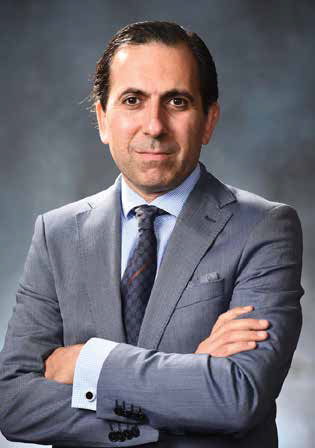
My father’s profession as a doctor heavily infl uenced me towards a career in medicine from an early age. I recall a formative moment at four years old when my grandmother underwent a gallbladder operation, sparking my interest. I played with her belly as a way of mimicking the role of a surgeon. Although I initially contemplated pursuing a career as a conductor due to my musical background in piano, my passion for medicine prevailed. At 19, I commenced my medical education at the esteemed Karolinska Institutet in Sweden, renowned for its contributions to medical science, including the Nobel Prize in Medicine. Following the completion of my degree and a mandatory two-year internship, I sought further experience in the United States, undertaking an internship at the University of Florida. Returning to Sweden, I embarked on a comprehensive orthopedic surgery residency at Karolinska Institute University Hospital, supplemented by a specialized fellowship in spine surgery. However, my fascination with neurosurgery burgeoned over time, captivated by its intricate technicalities and profound impact on human health. This led me to pursue a Post Doc at the Barrow Neurological Institute in Phoenix under the mentorship of Dr. Robert Spetzler, a luminary in the field.
My research during this period was recognized with an award from the American Association of Neurological Surgeons.
Encouraged by Dr. Spetzle, I expedited my transition into residency, enrolling at the University of Alabama in Birmingham. Leveraging my prior training, the residency duration was abbreviated, allowing me to further refi ne my skills through a fellowship with Dr. Takanori Fukushima in Japan, followed by a specialization in skull-base and cerebrovascular surgery under the tutelage of Professor Laligam Sekhar at the University of Washington in Seattle, pioneers in neurosurgery.
Establishing my clinical practice in Los Angeles, I also founded a non-profi t organization, “The National Skull- Base Foundation,” recognized as a 501C3 organization under U.S. tax law, dedicated to advancing research and education in the fi eld. After a decade in Los Angeles, a serendipitous opportunity arose during a lecture visit to Iran, prompting my relocation to Tehran to contribute to the advancement of modern neurosurgery.
Having traversed various corners of the globe, my roots in Iranian culture run deep, despite not being born there. At the tender age of fi ve months, I accompanied my mother to Iran, where I was raised by my maternal family, notably my literate grandfather, Mustafa Jaberi. Immersed in a milieu of intellectual discourse and literary pursuits, my formative years were steeped in a rich cultural tapestry, nurturing a profound connection to Iran. Refl ecting on my departure from Iran in 1984 at the age of 14, it wasn’t until recent years that the notion of returning began to percolate. Amidst the comforts of my established business and routines in Los Angeles, contemplating such a signifi cant transition necessitated a decisive catalyst. This impetus materialized during a visit to Iran, where I conducted a course and performed live operations, under the auspices of Professor Masih Saboori, then Chair of the Iranian Board of Neurosurgery. It became evident that my skills could contribute meaningfully to healthcare in Iran, particularly in the realm of complex neurosurgical cases.
Assessing the state of healthcare services in Iran reveals both strengths and shortcomings. While strides have been made in certain areas, such as radiation therapy centers and access to essential medications, systemic challenges persist. Declining nursing standards and inadequate reimbursements for medical practitioners pose signifi cant hurdles, exacerbating the risk of healthcare professionals emigrating. Furthermore, the proliferation of aesthetic surgeries contrasts sharply with the reluctance to pursue life-saving interventions, indicative of broader cultural perceptions towards medical treatment. Turning to brain-related illnesses, strokes emerge as a signifi cant concern in Iran, attributed in part to dietary habits and lifestyle factors. Despite the high prevalence, comprehensive stroke centers remain scarce, leaving many without timely access to critical care.
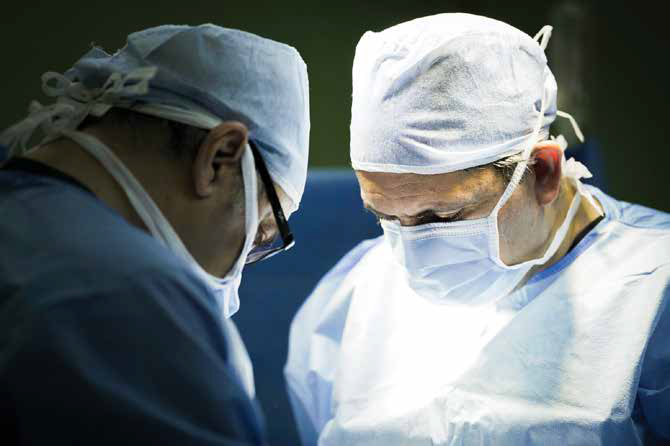
Additionally, malignant brain tumors, particularly glioblastomas and metastases, present formidable challenges, exacerbated by environmental factors such as pollution. Addressing these healthcare disparities necessitates a multifaceted approach, encompassing policy reforms, infrastructure investments, and cultural shifts towards proactive healthcare management. By fostering collaboration between healthcare stakeholders and prioritizing public health initiatives, Iran can aspire to achieve parity with global standards in healthcare delivery and outcomes.
I consider this question to be of paramount importance, drawing parallels to the historical pursuit of mapping human genes, particularly chromosomes. Refl ecting on the challenges encountered in that endeavor, it is pertinent to acknowledge the catalytic role played by prominent individuals who succumbed to diseases, igniting widespread interest and subsequent advancements in DNA research. Presently, our understanding of human DNA is extensive and pervasive, owing to signifi cant strides in scientifi c inquiry. Notably, targeted gene therapies have led to the successful treatment of numerous diseases. Consequently, the notion of downloading the contents of the human brain appears increasingly plausible. However, prior to its realization, it is imperative to address the logistical challenges associated with information transfer and storage. Assessing the ethical implications necessitates an appreciation of the potential misalignment with societal, cultural, and legal norms prevalent in various countries. The reluctance of individuals or communities to have their thoughts downloaded may stem from divergent values or concerns about privacy. Nevertheless, the inexorable march of scientifi c progress suggests that attempts to impede such advancements may prove futile in the long run. In contemplating the merits and demerits of brain-content transfer, I am inclined to believe that the benefi ts outweigh the drawbacks. Access to comprehensive knowledge enhances our understanding of the world around us, notwithstanding the acknowledgment that not all thoughts may align with societal norms. While concerns about the dissemination of undesirable or harmful content are valid, they do not diminish the potential transformative impact of widespread access to knowledge and information. Ultimately, the ethical considerations surrounding this prospect demand careful deliberation and interdisciplinary dialogue to navigate the complexities inherent in reshaping the boundaries of human cognition and morality.
Neuroscience encompasses the study of neurons, the spinal cord, and the brain, along with the supporting cells known as glia. This fi eld delves into the electrochemical processes underlying human brain function. Essentially, the brain operates through electrochemical signals transmitted along neurons. When an electrical signal travels down a neuron’s axon, it triggers the release of neurotransmitters, which then interact with recipient cells to produce further electrical reactions. These reactions govern various functions, such as movement, speech, and cognition.
As for neural regeneration, it explores the mechanisms by which damaged neurons and neural pathways can potentially repair and restore functionality. While peripheral nerves possess a remarkable capacity for regeneration, the central nervous system, comprising the brain and spinal cord, exhibits limited regenerative ability. Understanding this distinction is crucial for developing interventions to promote neural healing, particularly in cases of spinal cord injuries or neurodegenerative diseases.
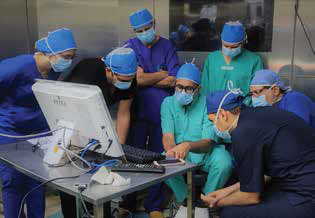
My interest in neural regeneration stems from the profound impact it can have on improving the lives of individuals with neurological disorders. By elucidating the factors that inhibit or facilitate neural repair, researchers aim to develop innovative therapies that harness the body’s innate healing mechanisms. For instance, my research on spinal cord injury involved utilizing hyaluronic acid gel as a scaffold to guide regenerating neurons across the injury site. This endeavor received recognition from the American Association of Neurological Surgeons, highlighting the signifi cance of such advancements in the field.
Moreover, in clinical practice, conditions such as trigeminal neuralgia often require collaboration with otolaryngologists (ENT doctors) for diagnosis and management. Trigeminal neuralgia, characterized by excruciating facial pain exacerbated by activities like coughing or sneezing, can be effectively treated with microvascular decompression (MVD) surgery. This procedure involves relieving pressure on the trigeminal nerve by placing a cushioning pad between it and surrounding blood vessels, thus alleviating the pain associated with this condition. This interdisciplinary approach underscores the importance of collaboration across medical specialties in providing comprehensive care for patients with neurological conditions.
Analyzing the human brain poses numerous challenges, particularly in light of the ever-evolving landscape of science and technology. A notable frontier in this realm is functional neurosurgery, a field that holds promise for resolving certain brain-related ailments.
Among the most signifi cant breakthroughs are treatments for Parkinson’s disease, tremors, and dystonia. Deep brain stimulation (DBS), a technique involving the placement of a pacemaker-like device in the chest to deliver energy to specifi c brain areas, has emerged as a key intervention. Additionally, ongoing research aims to expand treatment options for conditions such as obsessive-compulsive disorder (OCD) and depression, with investigations underway into areas like smoking cessation and hypertension. In the realm of tumor research, signifi cant strides have been made in identifying antigens, genes, and gene promoter sequences associated with various types of tumors, including gliomas. Despite these advancements, glioblastoma remains incurable, though surgical techniques combined with chemotherapy and radiation therapy can prolong life and enhance quality of life. Numerous trials are exploring targeted therapies aimed at tumor antigens, offering hope for future breakthroughs.
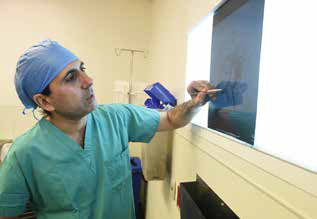
Stemming from advancements in immunotherapy, particularly in the context of HER2-positive breast cancer, there is growing optimism regarding the potential for tailored treatment approaches in oncology. While classical chemotherapy remains a cornerstone of cancer treatment, emerging immunological therapies show promise in targeting tumor cells more effectively. In the realm of spinal cord research, a focus on stem cell therapy holds potential, though signifi cant strides are needed before it becomes a viable treatment option. Notable progress has been made in the treatment of stroke through neurointerventional approaches, such as clot removal procedures conducted within the critical time window to prevent irreversible brain damage. Similarly, advancements in the treatment of aneurysms, including endovascular techniques and traditional microsurgery, underscore the multifaceted nature of modern neurosurgery.
Looking ahead, immunological tumors stand at the forefront of neuroscience and medical advancements, with ongoing research poised to revolutionize treatment paradigms. While neurointerventional techniques and functional neurosurgery remain pivotal, the integration of artifi cial intelligence (AI) holds the promise of further enhancing surgical precision and treatment outcomes. However, the evolution of AI in neurosurgery is not without challenges, particularly in complex procedures such as skullbase surgeries, where the surgeon’s judgment and nuanced decision-making play a critical role. While AI-powered robots may hold potential for certain surgical tasks in the future, the intricacies of neurosurgery demand a human touch and the expertise of skilled surgeons. As technology continues to advance, the intersection of neuroscience, AI, and medical innovation promises to usher in a new era of precision medicine and improved patient care.
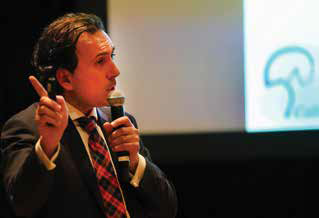
The prospect of completely downloading one’s brain contents, including memories, into a computer device raises profound ethical and philosophical questions. Drawing parallels with the mapping of human genes, advancements in understanding human DNA have led to breakthroughs in gene therapy and disease treatment. Similarly, the idea of brain content download may become a reality in the future, but its ethical implications are complex.
The ethicality of such an advancement is likely to vary across societies, cultures, and legal systems. While progress in science and knowledge is inevitable, the compatibility of brain content download with societal norms remains a key consideration. The potential benefi ts include the ability to preserve and transfer knowledge, fostering education and understanding of our surroundings. However, concerns arise regarding privacy, the nature of shared thoughts, and the potential misuse of this technology.
Interfering with the fundamental aspects of human nature and consciousness raises ethical dilemmas, especially if individual preferences and cultural values are not respected. Balancing the pros and cons will require careful consideration of the societal impact and the preservation of moral values. As with any technological advancement, responsible development and thoughtful ethical frameworks will be essential to navigate the complex terrain of brain content download.
When considering strategies for maintaining brain health and rejuvenation, there are several actionable steps individuals can take. One important aspect involves monitoring cholesterol levels, striving to keep them within a healthy range. Interestingly, recent scientifi c insights have shifted our understanding of cholesterol. While it was once believed that maintaining low cholesterol levels was universally benefi cial, newer studies suggest that moderately higher levels may not necessarily be harmful as long as they are within limits. Nonetheless, cholesterol remains implicated in various diseases, including vessel tightness and arteriosclerosis, which can lead to strokes. Consuming a diet rich in healthy, low-cholesterol foods is crucial for preventing these issues.
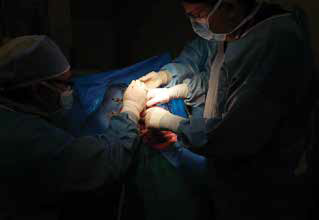
universally benefi cial, newer studies suggest that moderately higher levels may not necessarily be harmful as long as they are within limits. Nonetheless, cholesterol remains implicated in various diseases, including vessel tightness and arteriosclerosis, which can lead to strokes. Consuming a diet rich in healthy, low-cholesterol foods is crucial for preventing these issues.
Conversely, certain oils, such as “rogan” animal oils prevalent in Iran, contain high levels of saturated fats that contribute to bad cholesterol. In contrast, foods and oils containing green cholesterol, derived from vegetables like olives, can help block the absorption of harmful cholesterol from the digestive system. Another benefi cial practice for brain and overall health involves optimizing digestion by consuming high-fi ber foods. This aids in smoother and quicker food passage through the intestines, preventing blood sugar spikes that could lead to arteriosclerosis. Incorporating brainfriendly nutrients like walnuts and avocados, which contain vegetable cholesterol, can help maintain normal blood pressure and glucose levels. It’s essential to be mindful of the impact of dietary choices, as indulging in sweet and fatty foods, such as “noon khamei” in Iranian breakfasts, can negatively affect brain and body health. Instead, opting for healthier sweet options like dark chocolate can provide benefi ts, especially for brain function. Furthermore, it’s important to recognize the impact of beverages on health, as alcohol consumption has adverse effects on heart, liver, and pancreatic health, ultimately harming the brain.
Additionally, environmental factors like weather conditions and smoking habits play a signifi cant role in arteriosclerosis development, underscoring the importance of addressing these factors to protect brain and overall health.
Indeed, skull base surgeries typically demand extensive operating times due to the intricate nature of tumors nestled beneath the cranial base, intertwined with vital nerves and vessels. The meticulous dissection required to remove these tumors while preserving critical structures necessitates a comprehensive approach, often involving bone drilling and delicate maneuvering over an extended duration. For me, this isn’t merely a professional obligation; it embodies my passion. Operating on the brain is deeply fulfi lling, knowing that the outcomes profoundly impact individuals’ lives.
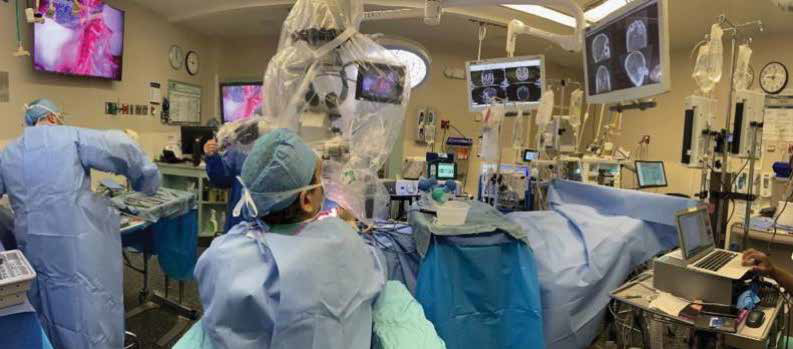
Technical advancements in neurosurgery have been instrumental in facilitating such procedures, from advanced microscopes to specialized instruments. However, mastery in this fi eld is cultivated through years of rigorous training, both in laboratory settings and clinical practice, often under the mentorship of seasoned experts worldwide.
Navigating the stressors inherent in neurosurgical practice is an intrinsic aspect of our profession. Emergency cases, demanding immediate attention even after exhaustive surgeries, are not uncommon. While this can induce fatigue and stress, it underscores the relentless commitment required in our fi eld. Preparation is key, whether meticulously studying imaging to visualize surgical approaches or engaging in thorough discussions with patients and their families. Emphasizing communication and education, particularly regarding surgical risks and alternatives, alleviates anxieties and fosters informed decision-making.
Post-surgery, while patients’ families may experience heightened stress, I prioritize providing comprehensive support and clarity regarding the patient’s condition and prognosis. Addressing misconceptions and managing expectations, especially in cases of malignant tumors, is essential to ensuring realistic outlooks and facilitating effective palliative care when needed.
Navigating the complexities of neurosurgical practice demands not only technical expertise but also compassionate patient care and effective communication, both pre- and post-operatively. It’s a testament to the multifaceted challenges and responsibilities inherent in our profession, underscored by the profound impact on patients’ lives and their families’ well-being.
Yes, I am. As a child, I received coins and banknotes as New Year presents, which sparked my interest in collecting. Over time, I gravitated towards collecting books and banknotes. It wasn’t until I completed my education and had a steady income that I delved into art collecting more seriously.
The pivotal moment came during my time in medical school when my father gave me $100 upon my arrival in Iran, encouraging me to spend it. I initially intended to purchase books but stumbled upon a beautiful Pilaram painting in an art gallery, which I acquired for 65,000 Tomans. That painting remains a cherished piece in my collection to this day. My interest in art was further fueled by observing the success of auctions featuring Pilaram’s work, particularly one at Christie’s, which fetched a substantial sum. Additionally, growing up surrounded by my father’s friends who were art enthusiasts and owned galleries in Sweden, cultivated my appreciation for art.
Most of my discretionary funds were allocated to art acquisitions, along with a few investments in Iranian rugs. I have a strong affi nity for modern art, both internationally and Iranian contemporary art, which I believe refl ects my passion for Iran—a nation rich in history, culture, and hospitality. While I don’t consider myself a dealer, I’m cognizant of the appreciating value of art over time.
Art serves as more than just a hobby; it provides solace and tranquility amidst life’s chaos. Picasso’s anecdote about valuing his art in terms of his lifetime experience resonates deeply with me: “12,000 francs for 83 years.”
It underscores the profound dedication and mastery required to create enduring works. Despite criticisms of high-priced art, it’s essential to recognize the skill, innovation, and legacy that artists contribute to the cultural landscape.

Iranian art, though undervalued on the global stage, possesses immense potential for appreciation. Comparisons between Iranian and international artists highlight disparities in valuation, yet fail to acknowledge the inherent quality and signifi cance of Iranian artistic contributions.
Encouragingly, there’s a burgeoning market for Iranian art, presenting promising opportunities for both collectors and artists alike. In addition to art, I have a fondness for Iranian rugs, particularly older pieces admired for their timeless beauty. However, I lament the decline in craftsmanship evident in newer rugs, which often lack the intricate designs and vibrant colors of their predecessors.
Outside of collecting, I indulge in reading, primarily historical books. It saddens me to witness low book edition numbers in Iran, indicative of declining readership. Reading provides me with a nightly ritual of learning and refl ection, enriching my understanding of the world and its complexities.
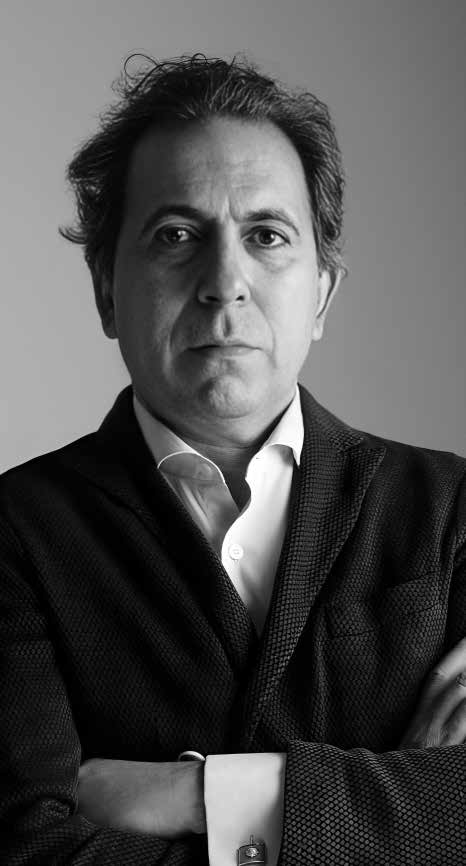
In terms of my aspirations within my fi eld, following extensive global travels and dedicating a signifi cant portion of my life to neurosurgery, my primary objective is to impart my knowledge to the next generation of neurosurgeons. I am currently engaged in teaching at Tehran University, at Sina Hospital. The emerging cohort of young neurosurgeons exhibits remarkable motivation and innate curiosity, eager to expand their expertise and maximize their potential.
However, their educational resources remain suboptimal. To equip them with the technical profi ciency commensurate with modern neurosurgical standards, enhanced access to advanced instruments, microscopes, and, critically, experienced mentors is imperative.
I am committed to maximizing my teaching efforts within these constraints. My ultimate aspiration is to establish a dedicated neuroscience hospital, equipped with cuttingedge resources and staffed by leading professionals. Such an institution would facilitate the comprehensive education and professional development of future neurosurgeons and neurologists, ensuring they remain abreast of the latest medical breakthroughs and advancements.
Opening Hours:
24/7
Address: Tradex Mena International Consulting Group L.L.C-FZ 6th Floor, Business Center, The Meydan Hotel Grandstand, Meydan Road, Nad Al Sheba, Dubai, United Arab Emirates
+971 50 240 9735
Address: TRADEX INTERNATIONAL CONSULTING DANIŞMANLIK
itH. iHr. ve TiC. LTD. ŞTi.
Tomtom Mah. istiklal Cad. Beyoğlu iş Merkezi No.187 iç Kapr No: 4 Beyoğlu/iSTANBUL Beyoğlu V.D. 8591125255
Very good